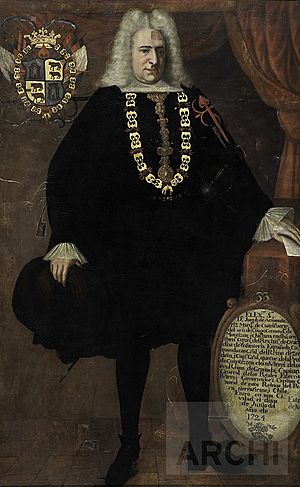José de Armendáriz, 1st Marquis of Castelfuerte facts for kids
Quick facts for kids
Don
José de Armendáriz
|
|
|---|---|
 |
|
| 28th Viceroy of Peru | |
| In office May 14, 1724 – February 4, 1736 |
|
| Monarch | Louis I |
| Preceded by | Diego Morcillo |
| Succeeded by | José Antonio de Mendoza |
| Personal details | |
| Born | Ribaforada, Navarre, Spain |
| Died | c. 1740 Madrid, Spain |
José de Armendáriz y Perurena, 1st Marquis of Castelfuerte (born in Ribaforada, Navarre, Spain – died around 1740 in Madrid, Spain) was an important Spanish soldier and leader. He served as the Viceroy of Peru from May 14, 1724, to February 4, 1736. He was known for fighting corruption and strengthening the economy in Peru.
Contents
Early Life and Military Career
José de Armendáriz joined the military when he was young. He fought for Philip V of Spain during the War of the Spanish Succession. This was a big war that decided who would be the next king of Spain.
He fought in many battles, including those in Naples, Sardinia, and Catalonia. He also took part in the siege of Gibraltar. For his brave service, King Philip V gave him the special title of Marquis of Castelfuerte in 1711.
Later, he became the governor of Tarragona and a top military commander in Guipúzcoa. After returning to Spain, he received two very high honors: he became a member of the Order of the Golden Fleece and the Order of Santiago.
Serving as Viceroy of Peru
In 1723, King Philip V chose José de Armendáriz to be the Viceroy of Peru. This was a very important job, like being the king's representative in a large colony. He started his work in May 1724.
Fighting Corruption and Improving Money
As viceroy, Armendáriz worked hard to stop cheating and corruption in the government. He wanted to make sure the royal treasury, which held the government's money, was managed fairly. He also improved how taxes were collected.
He focused on increasing the production of silver, which was very important for Spain. To do this, he strengthened the mita system. This was a system where Indigenous people were required to work in the silver mines.
Armendáriz was very strict about honesty. He even sent the director of the mint (where coins are made) and the assayer (who checks metal purity) to jail. They were caught making fake coins. To stop smuggling, especially of silver, he improved the navy and built stronger defenses along the coasts.
Recognizing Inca Nobles
He brought back a system that recognized Inca nobles as hijosdalgos of Castile. This meant they were given a special noble status, similar to Spanish nobility. This made many Indigenous noble families eager to prove their ancestry.
A New Drink in Lima
In 1724, people in Lima discovered a new and exciting drink: coffee. One person famously joked that "The new drink is as bitter as the new viceroy."
Challenges and Rebellions
During his time as viceroy, Armendáriz faced several uprisings. One of the most significant was the Comunero Revolt in Paraguay.
The Comunero Revolt
The governor of Paraguay, Diego de los Reyes Balmaseda, was not popular. He supported the Jesuits, who were disliked by some because they protected many Indigenous people from forced labor. An inspector named José de Antequera y Castro was sent to investigate.
However, Antequera sided with the "comuneros" (the rebels). He challenged the king's authority, put the governor in prison, and expelled the Jesuits. Antequera even defeated a royal army sent from Buenos Aires.
In 1724, Viceroy Armendáriz ordered the governor of Buenos Aires, Bruno Mauricio de Zabala, to stop the rebellion. He also ordered Antequera to be sent to Lima for trial. Antequera's followers left him, and he was arrested in 1725. He was later brought to trial in Lima and executed in 1731.
Even after Antequera's death, another revolt broke out in Paraguay in 1730. This new rebellion was led by Fernando Mompó de Zayas, who believed that the people's power was greater than the king's.
Other Uprisings
Armendáriz also dealt with other rebellions. In 1727, the Chiriguanos people, led by Aruma, had their first uprising. In 1730, there was another revolt in Oropesa, led by a Mestizo (person of mixed European and Indigenous ancestry) named Alejo Calatayud.
End of His Term and Later Life
In 1736, José de Armendáriz finished his term as Viceroy of Peru. He handed over his duties to his successor, José Antonio de Mendoza, 3rd Marquis of Villagarcía.
After leaving Peru, Armendáriz returned to Spain. He became a captain in the king's guard. In 1737, he was again honored as a Knight of the Order of the Golden Fleece. He passed away in 1740 and did not have any children.
See also
 In Spanish: José de Armendáriz para niños
In Spanish: José de Armendáriz para niños

